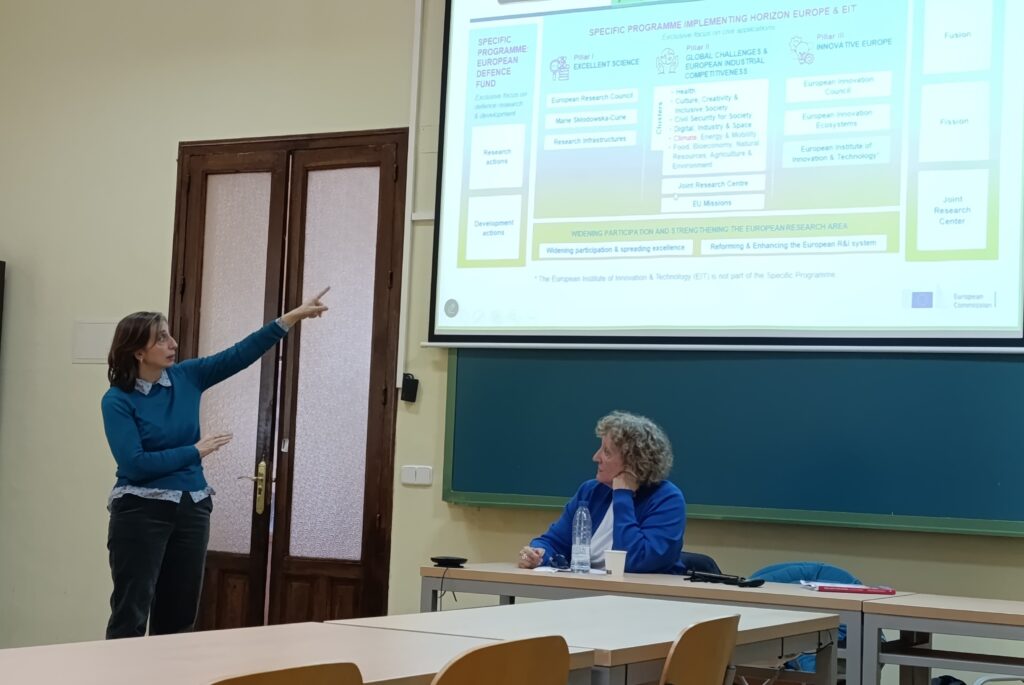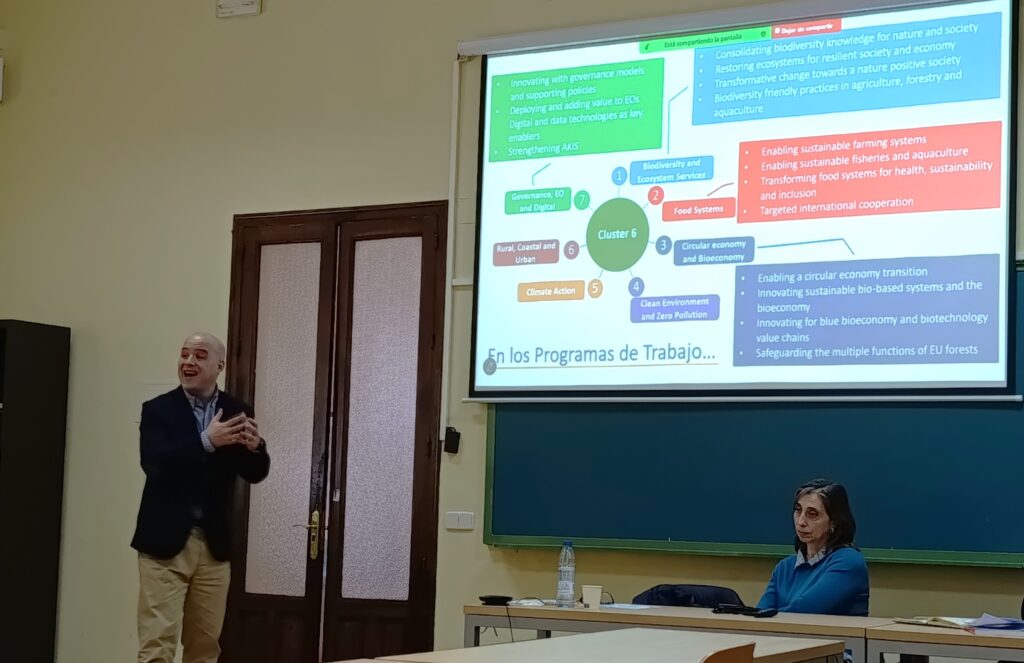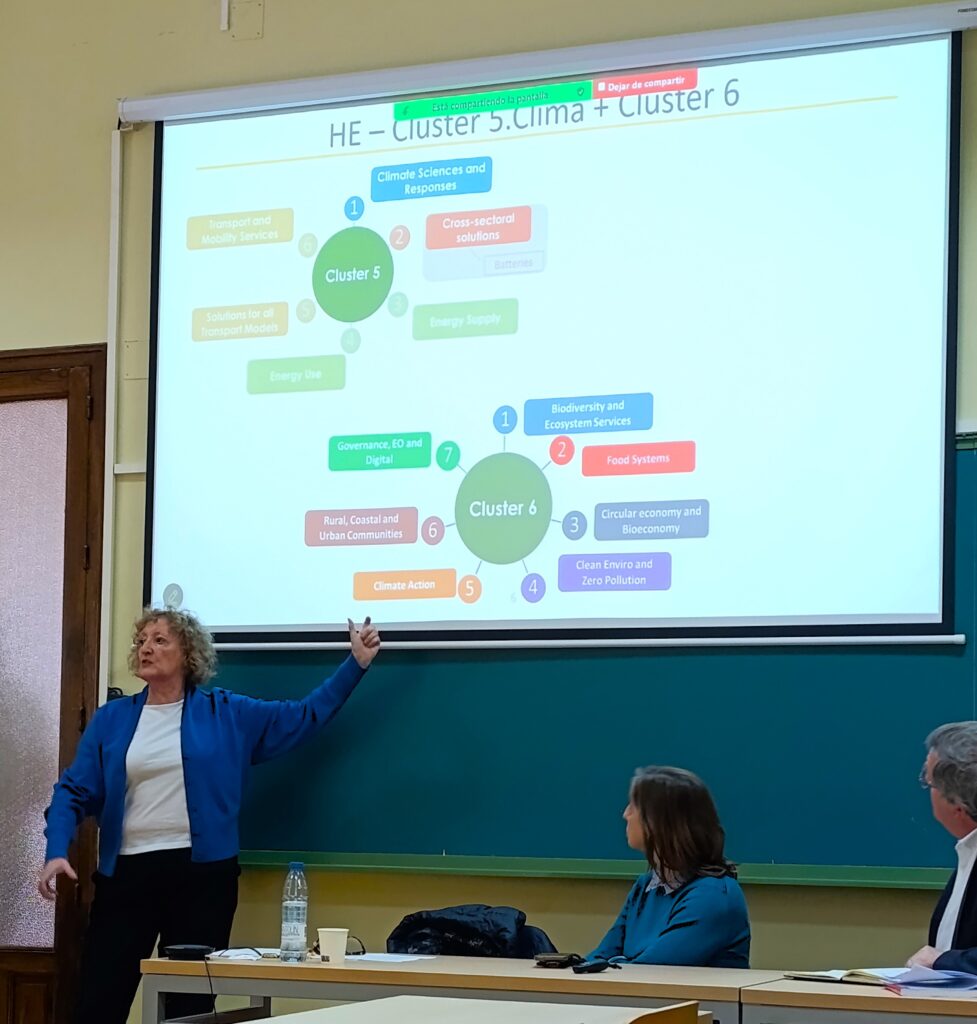How to connect research with European public policy: available initiatives and programs
Collaboration between the scientific community and the European Commission is essential for the development of effective strategies in areas such as climate change action and agricultural sustainability. In this context, the incorporation of Margarita Ruiz Ramos as Outstanding National Expert (END) in the European Commission was the reason why last week an event was held at the ETSIAAB on the ‘Strategic lines of European funding in climate change‘. In this event the different ways of collaboration for researchers of the ETSIAAB and the Universidad Politécnica de Madrid (UPM) to European policies and programs were presented.
At the event, representatives of the Center for Technological Development and Innovation (CDTI) and the European Commission stressed the importance of involving researchers in the different processes of elaboration of European framework programs and projects. The Commission actively invites scientists to participate in several ways, which were explained in detail during the event:
- Contributing to the drafts of future calls for proposals, providing their knowledge and experience to better define the lines of research funded by the EU.
- Participating in shaping the Spanish position on the Framework Program, collaborating in the design of long-term strategies to guide research and innovation in Europe.
- Being part of the National Experts programs, when expert profiles in different fields are requested. Technical and scientific profiles are of great interest for advising the Commission on specific topics for the elaboration of future programs and action frameworks. This is the case of Professor Margarita Ruiz-Ramos.
- Presenting project proposals in Framework Program calls, accessing funding opportunities to carry out applied research with real impact on the development of public policies and on the productive sector. It was insisted on reviewing in detail the different clusters, and not only those specific to agriculture and climate, since adaptation to climate change is a cross-cutting issue that can fit into other clusters.
- Joining European networks and consortia, strengthening cooperation with other universities, research centers and companies at the international level. These collaboration agreements can be key to lay the foundations for future agreements and joint projects within partnerships or EU Missions.
The presence of Margarita Ruiz-Ramos at the European Commission represents a strategic opportunity to strengthen the connection between the UPM and European organizations. With events like this, we are actively working to bring the work of the CDTI and the European Commission closer to the research community of the ETSIAAB and the UPM, promoting a closer and more effective collaboration with the EU Framework Programs.
Both CDTI and the European Commission encouraged researchers to take advantage of these opportunities and to remain active in the various consultation and participation processes. In a context of ecological and digital transition, scientific collaboration with European institutions is key to ensure that research policies and programs respond to today’s global challenges.




Short interview with Margarita Ruiz-Ramos
Margarita Ruiz-Ramos is a Full Professor in the Department of Agricultural Production at the Escuela Técnica Superior de Ingeniería Agronómica, Alimentaria y de Biosistemas (ETSIAAB), and was secretary of the Research Center for the Management of Agricultural and Environmental Risk (CEIGRAM) until she joined the EC and belongs to the research group Sistemas Agrarios (AgSystems).
Since December 1, 2023, she has been participating in the National Experts Programme, through which the member states of the European Union send, for a limited period of time, officials specialized in a field in which the European Commission requires expert advice. Margarita Ruiz-Ramos has joined the Directorate General for Research and Innovation and, specifically, the Climate and Planetary Boundaries Unit.
Taking the opportunity of her visit to the UPM in the event ‘Strategic lines of European funding in climate change’, we wanted to ask her a series of questions to shed light on the forms of collaboration and ways of co-creation between researchers and decision-makers.
CC: How do you think it is possible to encourage greater participation of the research community in the formulation and management of public policies?
MRR: It is important that both sides make an effort. On the side of researchers, they can engage in communication actions, in which decision-makers at different levels or at the scale relevant to their research (regional, national, interregional or European) are invited as a priority audience. Specific products should also be prepared for legislators: Policy Briefs, one- or two-page summaries with key messages translating the results and knowledge into keys that are useful for the decision-maker. Finally, researchers should take into account the knowledge needs of policy makers (research gaps) when deciding their research priorities.
On the side of the decision-makers, they should be available to participate in these events and to exchange this information on behalf of the scientific community, and express their needs within what is feasible for researchers.
CC: What recommendations would you give to researchers who want to become more involved in advising policy makers?
MRR: I would suggest that they participate as scientific advisors on panels of policy-making agencies at the local, national, and European levels. The Leading National Experts program is one example, but ANECA, AEI and other agencies are looking for scientific collaborators for many tasks. There are several ministries that also require expert advisors. It is a matter of being available for these tasks.
CC: What mechanisms are in place for research groups to collaborate with the European Commission in policy development and evaluation?
MRR: We have seen at the event the different ways for individual researchers to participate. For research groups, the best way is to go to the proposals, i.e. the calls for proposals, and to translate or summarize the results of these projects in Policy Briefs that can then be sent to decision makers.



